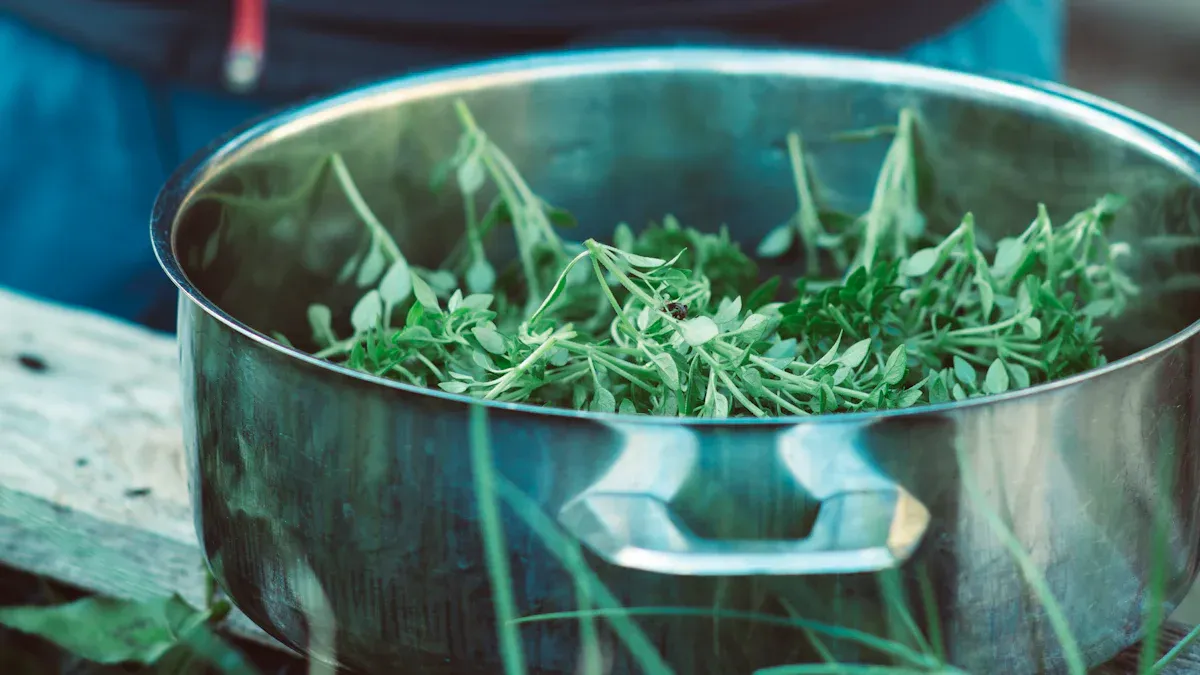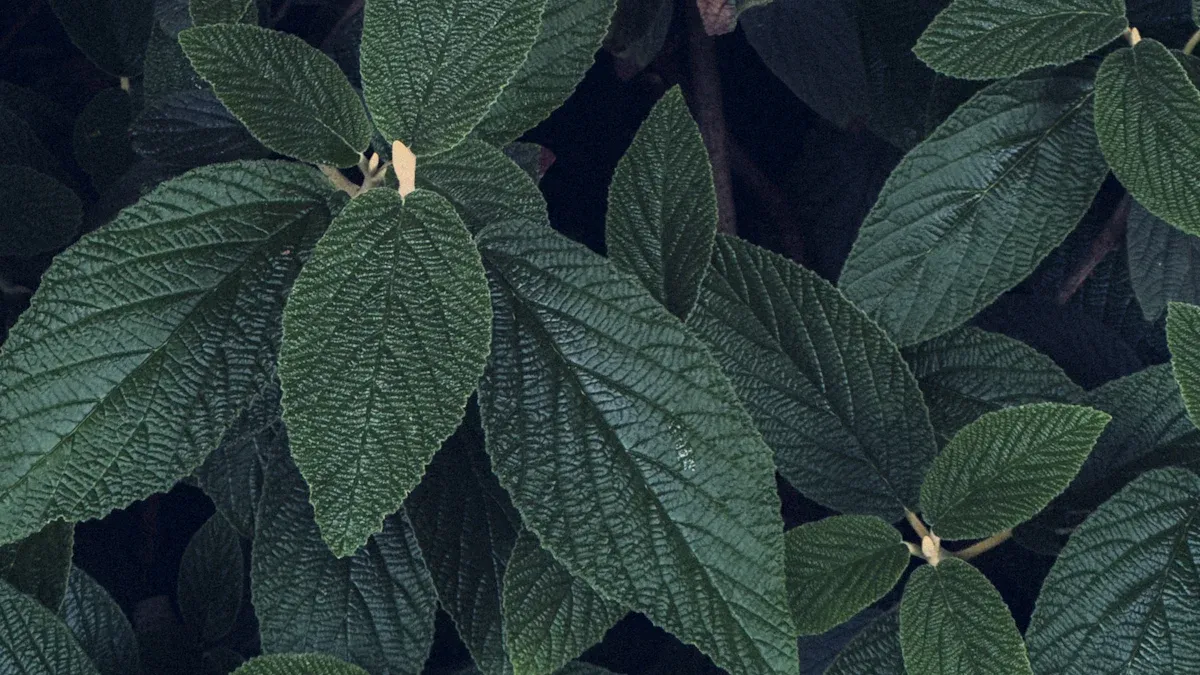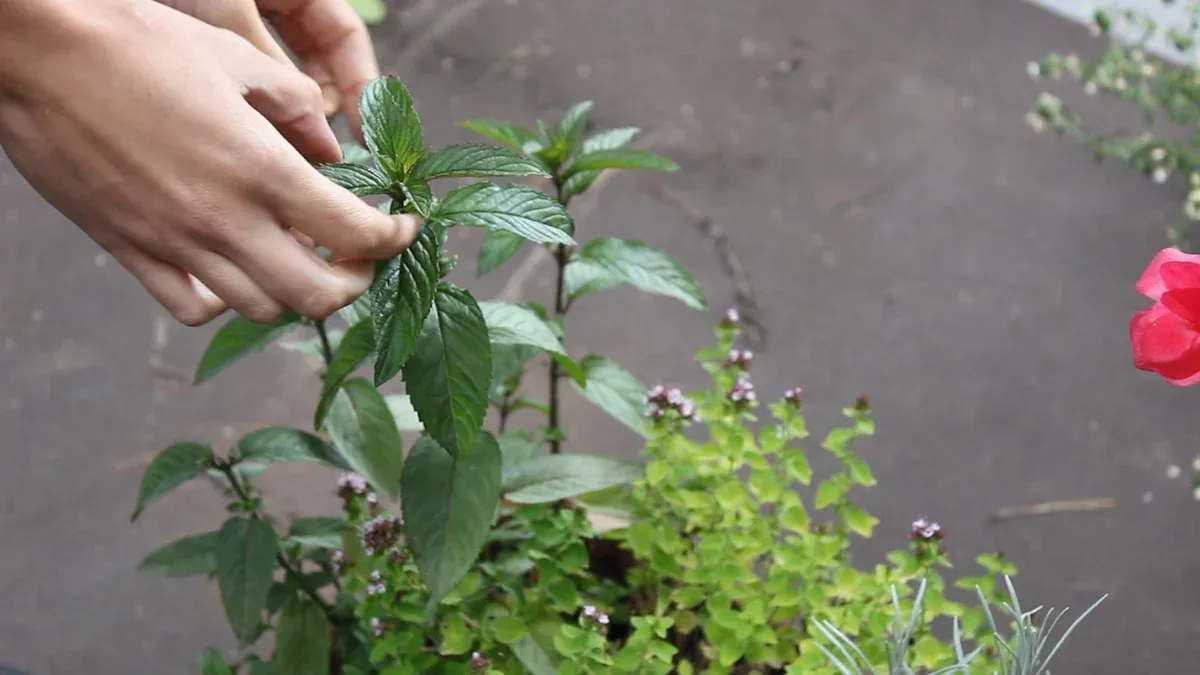
Timing is crucial in perilla plant harvesting. When you harvest at the right moment, you enhance the flavor and maximize your yield. Look for these key indicators to determine readiness:
The leaves should be vibrant and firm.
The plant may begin to flower, indicating maturity.
Height and growth stage can also guide your decision.
By paying attention to these signs, you can ensure a successful harvest and enjoy the best of what your perilla plants have to offer.
Key Takeaways
Harvest perilla leaves when they are vibrant green and firm for the best flavor.
Look for flowering stages to enhance flavor and yield; harvest around 80-95 days after planting.
Use sharp scissors to cut leaves just above the node, promoting new growth.
Water your perilla plants deeply but infrequently to encourage strong roots.
Practice continuous harvesting by taking no more than one-third of the plant at a time.
Readiness Signs

Leaf Color and Texture
When you look at your perilla plants, pay close attention to the leaves. Healthy perilla leaves should exhibit a vibrant green color and a firm texture. This indicates that the plant is in its prime for harvesting. Leaves that are dull or yellowing may suggest that the plant is stressed or past its peak.
Tip: Harvest leaves when they are young and tender for the best flavor. Older leaves can become tough and bitter.
Flowering Stage
The flowering stage is another critical indicator of readiness. Research shows that the flowering stage significantly influences the flavor and yield of perilla plants. During this time, the plant regulates metabolites, leading to an increase in flavonoids. These compounds are essential for enhancing flavor and therapeutic properties. Therefore, harvesting during the flowering stage can yield a more flavorful crop.
Recommended Height | Growth Stage for Harvesting |
|---|---|
8 inches or taller | Leaves can be harvested as needed after reaching this height. |
80-95 days | General time frame for readiness to harvest. |
You can expect your perilla plants to be ready for harvest approximately 80-95 days after planting. Start harvesting leaves once the plants reach a height of at least 8 inches. This height ensures that the leaves are large enough to eat and flavorful.
Environmental factors also play a role in the readiness signs of perilla plants. Conditions such as salinity, drought, and heat can affect how well your plants thrive. Observations indicate that perilla plants can adapt to these stresses, which may enhance their resilience and overall yield.
By monitoring leaf color, texture, and the flowering stage, you can determine the optimal time to harvest your perilla plants. This attention to detail will help you enjoy the best flavor and yield from your crop.
Perilla Plant Harvesting Techniques

How to Harvest Shiso
When you harvest shiso, timing and technique matter. Follow these best practices to ensure you preserve the quality of your leaves and maximize your yield:
Prune flowers: Snip off any flower spikes as soon as they appear. This action prevents the plant from going to seed and helps prolong your harvesting period. By doing this, you maintain the quality of the leaves and encourage further growth.
Harvest in the morning: Aim to harvest your perilla plants early in the day. During this time, oil levels peak, enhancing the aroma and flavor of the leaves. You’ll notice a delightful scent reminiscent of a midnight ramen bar filling your kitchen.
Cutting Methods
Using the right cutting methods can make a significant difference in your harvest. Here are some effective techniques:
Use sharp scissors or garden shears: Always opt for clean, sharp tools. This choice minimizes damage to the plant and ensures a clean cut.
Cut above the leaf node: When harvesting, cut just above a leaf node. This practice encourages new growth and allows the plant to continue producing leaves.
Leave some leaves on the plant: Avoid stripping the plant bare. Leaving some leaves ensures that the plant can photosynthesize and remain healthy for future harvests.
After harvesting, you can store your shiso leaves effectively. Here are some recommended methods:
Method | Description |
|---|---|
Refrigeration | Wrap perilla leaves loosely in a paper towel to absorb moisture and store them in a plastic bag. |
Freezing | Wash, dry, and place leaves in freezer bags or roll them into a log and wrap in plastic or foil. |
By following these techniques, you can enjoy fresh shiso leaves for a longer period. Remember, the key to successful harvesting lies in your attention to detail and care for the plant.
Maximizing Your Crop Yield
Soil and Nutrient Management
To maximize your perilla crop yield, focus on soil and nutrient management. Start by testing your soil pH. The optimal pH for perilla is between 6.0 and 6.8. This range supports most cultivated plants.
For nutrient levels, aim for the following:
Nitrogen: 225 kg N ha−1
Phosphorus: 100 kg P2O5 ha−1
Potassium: 125 kg K2O ha−1
Adding organic matter to your soil can also boost yield. Research shows that using organomineral fertilizers improves overall soil fertility. This practice increases total carbon and potassium levels, which are essential for healthy plant growth.
Remember, a healthy soil promotes a thriving perilla plant.
Watering Practices
Watering practices significantly impact the growth of your perilla plants. Consistent water availability helps develop strong root systems. A study indicates that stable water supply leads to better root allocation and overall biomass. This means you should aim for regular watering, especially during dry spells.
Water deeply but infrequently to encourage deep root growth.
Avoid overwatering, as this can lead to root rot and other issues.
By managing your soil and watering practices effectively, you can enhance the yield of your perilla plants. Healthy plants produce more flavorful leaves, allowing you to enjoy the best of your shiso harvest.
Pest Control
Pest control also plays a vital role in maximizing your crop yield. Implementing effective pest management strategies can protect your plants from damage. Here are some methods to consider:
Herbicide | Type | Application Timing |
|---|---|---|
Picloram | Preemergence | Before seedling emergence |
Aminopyralid | Preemergence | Before seedling emergence |
Dicamba | Preemergence | Before seedling emergence |
Imazapic | Preemergence | Before seedling emergence |
2,4-D | Postemergence | From seedling through early flowering stage |
Glyphosate | Postemergence | From seedling through early flowering stage |
Mowing | Physical | Before flowering in late summer |
Hand pulling | Physical | Before flowering in late summer |
Using natural plant products can also help. These environmentally friendly alternatives protect against pests and can increase your crop yield.
By focusing on soil health, proper watering, and pest control, you can maximize your perilla crop yield and enjoy a bountiful harvest of shiso leaves.
Harvesting Shiso Leaves
Continuous Harvesting
To enjoy a steady supply of fresh shiso leaves, you should practice continuous harvesting. This method encourages the plant to grow more leaves and prolongs its life. Aim to harvest no more than one-third of the plant’s total mass at any time. This practice prevents hindering future growth and keeps your plants healthy.
Start harvesting when the leaves are young and tender.
Mature leaves can be harvested about eight weeks after sowing.
Continue harvesting throughout the summer for the best flavor and yield.
By following these guidelines, you can ensure that your shiso plants remain productive and flavorful.
Seed Collection
Collecting seeds from your shiso plants can be rewarding. It allows you to grow new plants in the next season. Here are some best practices for collecting perilla seeds to ensure high germination rates:
Practice | Description |
|---|---|
Soaking | Soak the seeds in lukewarm water for 12–24 hours to stimulate the process. |
Scarification | Gently rub seeds with sandpaper or briefly dip them in hot water (around 60°C) to help soften the seed coat. |
Rinsing | Rinse seeds thoroughly before sowing to remove natural germination inhibitors. |
Light exposure | Do not cover seeds with soil, so they have access to light. Wrap your tray in clear stretch foil and place it under grow lights. |
Optimal conditions | Keep the growing environment at 22–25°C with high humidity for the best chance of success. |
By following these steps, you can maximize your chances of successful germination and enjoy a new crop of shiso plants in the future.
In summary, proper timing and techniques are essential for successful perilla plant harvesting. By focusing on signs of readiness, you can enhance flavor and yield. Implementing effective harvesting techniques, such as pruning and deadheading, contributes to long-term gardening success. Consider the following benefits of these techniques:
Technique | Benefit |
|---|---|
Pruning | Influences plant shape, productivity, and lifespan. |
Pinching for Bushiness | Stimulates new side shoots for a fuller, bushier plant with more leaves to harvest. |
Harvesting as Pruning | Encourages branching habit by cutting stems just above developing leaves. |
Deadheading for Longevity | Redirects energy back into foliage, prolonging leaf production and controlling self-seeding. |
Apply these tips to maximize your perilla crop and enjoy a bountiful harvest! 🌱
FAQ
What is the best time to harvest perilla leaves?
Harvest perilla leaves in the morning. This timing ensures the highest oil levels, enhancing flavor and aroma.
How often should I harvest my perilla plants?
You can harvest your perilla plants continuously. Aim to take no more than one-third of the plant at a time to promote healthy growth.
Can I grow perilla in containers?
Yes, you can grow perilla in containers. Ensure the container has good drainage and use quality potting soil for optimal growth.
How do I store harvested perilla leaves?
Store harvested leaves in the refrigerator wrapped in a paper towel. This method keeps them fresh for longer.
What pests should I watch for when growing perilla?
Watch for aphids and spider mites. Regularly inspect your plants and use natural pest control methods to protect them.

